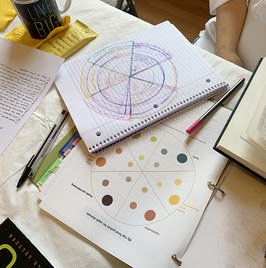Seek Inspiration to Ignite Your Spirit
/For many people in the US, last week’s Thanksgiving holiday meant lots of sharing with family and friends. Many traveled or hosted gatherings, and some started shopping for the upcoming holidays.
All of the busyness was likely to have crowded out time for slowing down, savoring some quiet, and doing a bit of reflection.
And while the stimulation around the holiday may have felt great, there’s another kind of stimulation I treasure, that most women skimp on.
Stimulation can take different forms
The stimulation I carefully make time for — throughout the year — is found when I seek inspiration.
I make time to fill myself with wonder. I take in beauty for the sole purpose of opening my heart and expanding my spirit.
Sometimes that means going for a walk on a lovely day and pausing to notice the way the clouds look in the sky, the textures in the bark of a tree, the colors of a beautifully painted house, or the joy on the face of an adorable child walking with a parent.
Sometimes, I spend an hour at a local museum to see the work of an artist I love, or to discover something unexpected made by an artist whose work I’ve never seen before.
Sometimes I travel to experience scenery, food, art, history or music that is unique or new to me.
Sometimes I meet with a friend I have missed, and share an especially delicious cup of tea or coffee in a cozy shop.
The gifts are bountiful and splendid
Each time I treat myself to an hour or day or weekend (or a longer excursion) that offers me something special that is not part of my routine life, I feel amazed at what happens.
My spirit is ignited by the delight I feel.
My energy is boosted and my curiosity is fueled.
I find myself amazed by the creativity I have witnessed, and my creative fires are stoked in ways that lead to new forms of expression, sparks of insight, bigger ideas, and better solutions to conundrums I am sorting out.
I am able to reflect on everything in my current situation with fresh perspective.
And I feel new levels of joy, deeper love, and more grateful for everything in my life.
I invite you to seek opportunities to honor yourself and light up your spirit.
Email me to share how your joy is sparked and your creative power is ignited!




























































